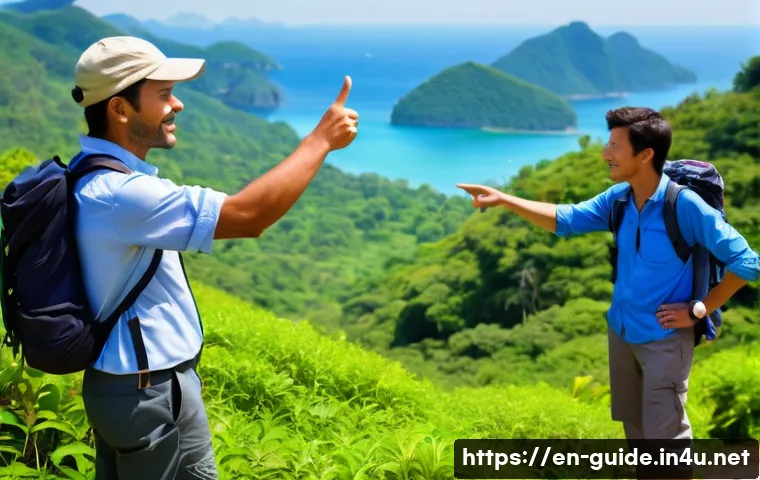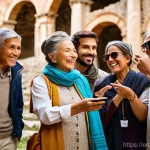It’s been quite a ride watching the travel industry transform right before our eyes, hasn’t it? From navigating ancient ruins to bustling modern metropolises, the role of a tourist interpreter guide has always been vital, but lately, it feels like we’re experiencing a seismic shift.

Forget everything you thought you knew about guiding; the rules of the game are changing, and frankly, it’s thrilling to witness. We’re seeing nations worldwide, from Italy to Jordan, rolling out fresh legislation designed to elevate our profession, ensure quality, and keep up with the dynamic demands of global tourism.
This isn’t just about new paperwork; it’s about formalizing our expertise, cracking down on unregulated practices, and even embracing cutting-edge tech.
I’ve been digging deep into these exciting developments, and trust me, there’s a lot to unpack. The future of guiding is looking brighter and more regulated than ever, challenging us to step up our game and embrace new opportunities.
You might be wondering how these sweeping changes could impact your own journey or even reshape your next travel experience, especially with digital tools and sustainability becoming key players.
Don’t worry, I’ve got you covered. Let’s dive into the details below to truly understand what’s happening.
Navigating the Evolving Landscape of Tourist Guiding
Alright, let’s get right into it, because the world of guiding is seriously changing, and in some fantastic ways! I’ve been in this industry long enough to remember when a good map and a loud voice were pretty much your main tools.
But wow, have things evolved! Now, we’re talking about sophisticated legal frameworks, cutting-edge technology, and a whole new emphasis on responsible travel.
It’s not just about knowing your history; it’s about understanding the intricate dance between local regulations, global trends, and the ever-growing expectations of travelers.
Many nations are really stepping up their game to ensure quality and professionalism, which, from where I’m standing, is a huge win for everyone involved.
I mean, who wants a sub-par experience when you’re exploring a new place, right? This push towards formalizing our profession isn’t just about red tape; it’s about elevating our craft and making sure tourists get the best possible insights.
The focus is clearly on safeguarding the integrity of our historical sites and cultural narratives, making sure that every story told is accurate, engaging, and respectful.
It’s a dynamic period, and honestly, it’s keeping us all on our toes, encouraging continuous learning and adaptation. This commitment to ongoing development means we, as guides, are constantly honing our skills, diving deeper into local lore, and even picking up new languages or tech proficiencies.
It’s a challenge, sure, but it’s also incredibly rewarding to be part of a profession that’s continually striving for excellence and greater impact.
New Rules of Engagement: Global Legislative Shifts
First up, let’s talk about the big legislative movements that are shaking things up. Italy, a country I absolutely adore and have spent countless hours exploring, has recently enacted some pretty significant changes. You know, for years, the rules for guides there felt a bit like a tangled spaghetti junction, with regional variations making things unnecessarily complex. But finally, they’ve introduced Law 190/2023, which aims to create a more unified national approach to the tourist guide profession. This isn’t just a minor tweak; it’s a fundamental shift designed to standardize qualifications and crack down on unlicensed operators. I’ve seen firsthand how disruptive unofficial guides can be, not only for the quality of the tour but also for the livelihood of legitimate professionals. This new law in Italy, operational since July 2024 with its implementing regulations, requires guides to pass a national qualification exam or have their foreign qualifications recognized. It even mandates professional civil liability insurance and identification cards issued by the Ministry of Tourism. Honestly, it’s about time! This formalization provides a layer of credibility and protection that was sorely needed. They’re also talking about mandatory refresher courses every three years, which I think is brilliant – it ensures guides are always up-to-date, not just on historical facts but also on evolving best practices and new discoveries. It’s all part of a broader European trend, too, where the focus is on clear definitions, professional recognition, and combating illegal practices. Countries like Greece have also seen new tourism bills passed that protect the profession and include guides in national social security systems, which is fantastic for job security and professional standing. It really feels like the whole industry is pushing for higher standards, and that can only be a good thing for travelers seeking authentic and informed experiences.
Protecting Our Profession from Unlicensed Operations
Speaking of quality, let’s be real: unlicensed guides are a persistent headache, and honestly, they undermine the entire profession. It’s frustrating when you’ve invested years in training, certifications, and building up a reputation, only for someone to swoop in with little to no genuine expertise. That’s why I’m personally thrilled to see stronger stances against these “fly-by-night” operations. Italy’s new law, for instance, has serious teeth, with hefty fines ranging from €1,500 to €6,000 for guides who fail to present the mandatory prior declaration or identification cards. And it gets even better: intermediaries who connect tourists with unlicensed individuals can face fines from €5,000 to €15,000! This isn’t just about protecting our jobs; it’s about safeguarding the traveler’s experience and ensuring they receive accurate, high-quality information. In Jordan, the updated Tourism Law 2024 is equally robust, stipulating imprisonment for up to three years or fines up to JD10,000 (that’s Jordanian Dinars) for anyone engaging in tourism activities without proper approval. I remember a time when proving you were a certified guide felt like an uphill battle, but with these new regulations, the playing field is becoming much fairer. It’s a welcome change, creating a more secure environment for those of us who have dedicated our lives to this calling. These laws help solidify the importance of proper training and accreditation, which, in turn, boosts the overall credibility and authority of the guiding profession. It’s a testament to the fact that genuine expertise and professionalism are truly valued, and frankly, I think that’s something worth celebrating.
Embracing the Digital Frontier: Tools for Modern Guiding
Honestly, if you’re not using digital tools in your guiding practice these days, you’re missing out big time. Technology isn’t just a nice-to-have; it’s become an absolute game-changer.
I’ve seen how integrating digital solutions can transform a good tour into an unforgettable, seamless experience for everyone. From keeping groups together to providing rich, interactive content, the advancements we’re seeing are truly exciting.
It’s not about replacing the human element, which is irreplaceable, but about enhancing it. Imagine being able to instantly share fascinating historical images on a tablet, or providing real-time translations for a diverse group – that’s the power we’re talking about.
These tools free us up to focus on the storytelling, the personal connections, and those spontaneous, magical moments that make a tour truly special.
Revolutionizing Communication and Engagement
One of the biggest shifts I’ve experienced is in how we communicate on tours. Gone are the days of shouting over crowds or struggling to keep everyone within earshot. Digital radio systems and wireless tour guide systems have been an absolute blessing. They provide crystal-clear sound, even in bustling city centers or expansive outdoor sites, ensuring every member of the group, no matter where they’re standing, hears every word. I can vividly recall leading a large group through a noisy market in Marrakech, and before these systems, it was a constant battle to convey information. Now, with a discreet earpiece, everyone’s connected, and I can talk in a natural tone, making the experience far more intimate and engaging. These systems also offer multi-channel communication, which is fantastic for multilingual groups, allowing interpreters to provide real-time translations without disturbing others. Beyond audio, mobile applications are becoming indispensable. Platforms like SmartGuide offer self-guided tours in over 1500 destinations, allowing guides to create and customize engaging digital content. These apps often include audio and video content, even augmented reality experiences that bring historical sites to life right on a traveler’s smartphone. Imagine pointing your phone at an ancient ruin and seeing a 3D reconstruction of what it looked like centuries ago – it’s mind-blowing and adds such a rich layer to the narrative! This interactive engagement deepens understanding and caters to the modern traveler’s desire for immersive experiences.
Immersive Experiences and Accessibility Enhancements
And it’s not just about what we say, but how we *show* it. Immersive technologies are rapidly changing how tourists interact with destinations. Augmented Reality (AR) and Virtual Reality (VR) are no longer just sci-fi concepts; they’re becoming practical tools for guides. I’ve experimented with AR applications that allow me to overlay historical maps or architectural renderings onto the live view from a visitor’s phone, giving them a “through the ages” perspective that static images simply can’t match. This kind of tech allows us to offer narratives that go far beyond traditional storytelling, making history and culture tangible. Think about it: instead of just describing a Roman gladiator arena, a visitor could see a virtual reconstruction of a bustling crowd and a fight in progress, right in front of them! Moreover, these digital advancements are huge for accessibility. AI tour guides, like “Waddi” on the island of Fanø in Denmark, can answer questions about localities and provide real-time information, making travel more inclusive. For people with disabilities, seniors, or even those with young children, accessible digital content and smart routing can make a world of difference, ensuring everyone can enjoy and understand a destination. It’s all about creating a richer, more personal, and more accessible experience for every single person on our tours. The ability of AI to optimize itineraries based on local weather or congestion also means smoother, more enjoyable trips for our guests. It feels like we’re just scratching the surface of what’s possible, and that’s incredibly exciting!
The Green Shift: Sustainable Tourism Guiding
Okay, let’s talk about something incredibly close to my heart: sustainable tourism. This isn’t just a buzzword anymore; it’s a fundamental pillar of how we approach travel.
I’ve seen a massive shift in traveler consciousness, and honestly, it’s inspiring. People genuinely want to experience the world without leaving a negative footprint, and as guides, we’re on the front lines of making that happen.
It’s about preserving the beauty and integrity of the places we love, not just for ourselves but for generations to come. This commitment impacts everything from the accommodations we recommend to the stories we tell.
Guiding with an Eco-Conscious Mindset
Being a guide today means being an advocate for the environment and local communities. The demand for sustainable travel experiences is absolutely surging, with many travelers actively seeking out eco-friendly options. This means we’re increasingly partnering with accommodations that prioritize green practices, such as using renewable energy or implementing water conservation methods. I personally make it a point to highlight local businesses and artisans, ensuring that tourism revenue directly benefits the people who live in the destination. It’s about fostering genuine community-centric tourism, where visitors get authentic experiences while supporting sustainable economic development. I’ve often steered my groups towards locally-run eateries or craft shops, not just because they offer unique products, but because it feels good to know our presence is making a positive impact. Furthermore, there’s a strong push towards “regenerative tourism,” which goes beyond just minimizing harm to actively leaving a place better than we found it. This could involve participating in local conservation projects or supporting initiatives that restore natural habitats. It’s an empowering feeling to know that our tours can contribute to the health and vitality of both ecosystems and communities. In places like Sardinia, for example, new laws limit beach access and require online booking and fees for certain spots, often with a guide, to protect the environment and manage crowds. These regulations, while seemingly restrictive, are crucial steps towards preserving fragile ecosystems and cultural heritage. It’s a collective effort, and as guides, we play a pivotal role in educating travelers and encouraging responsible behavior. We often lead by example, promoting practices like reducing single-use plastics and respecting local wildlife and natural habitats.
Balancing Visitor Flow and Local Preservation
Another critical aspect of sustainable guiding is managing visitor flow, especially in popular, often overcrowded destinations. Cities like Venice and Rome are at the forefront of this challenge, enacting new rules to combat overtourism. I’ve seen Venice implement a tourist tax for day-trippers and, more recently, legislation limiting tour groups to a maximum of 25 people. They’ve even banned loudspeakers, making audio guides mandatory for groups larger than ten to reduce noise and confusion in the historic center. I remember the chaos of large groups with multiple guides all speaking at once – it was overwhelming for residents and tourists alike. These measures, while initially met with some resistance, are essential for preserving the quality of life for locals and the integrity of these incredible sites. Rome, too, is exploring options like timed access and small entry charges for non-residents at iconic landmarks like the Trevi Fountain, especially with the upcoming Jubilee in 2025 expecting millions of pilgrims. These aren’t just arbitrary rules; they’re thoughtful strategies to balance the needs of tourism with local preservation. As guides, we’re adapting by promoting off-the-beaten-path experiences and encouraging visitors to explore lesser-known neighborhoods, which not only alleviates pressure on famous sites but also offers a more authentic glimpse into local life. It’s about spreading the love, both geographically and economically, and ensuring that the magic of these places isn’t lost to sheer volume. The goal, ultimately, is to create meaningful experiences that benefit everyone involved, from the traveler to the local community.
Skills for the Modern Guide: Beyond Facts and Figures
The days of simply rattling off historical dates are long gone. Today, being a great guide is about so much more than just possessing encyclopedic knowledge.
It’s about connection, adaptation, and truly enriching a traveler’s journey. I’ve personally found that the most memorable tours aren’t necessarily the ones with the most facts, but the ones where I managed to forge a genuine connection with the group, making the history and culture truly come alive.
It’s a blend of art and science, requiring a continuous commitment to personal growth and professional development.
Cultivating Core Competencies for Impactful Tours
At the heart of modern guiding lies exceptional communication. It’s not just about speaking clearly; it’s about engaging your audience, captivating them with stories, and knowing how to adapt your delivery to different personalities and learning styles. I’ve learned that a compelling narrative can transform a dry historical fact into a vivid, relatable experience. It requires active listening, too – really understanding what your group is interested in, and being flexible enough to pivot if their curiosity leads down an unexpected path. A keen memory is, of course, a huge asset, not just for recalling dates and names, but also for remembering a guest’s interests or a humorous interaction from earlier in the day, which makes the experience feel incredibly personal. Beyond that, adaptability is non-negotiable. Unexpected situations pop up all the time – sudden changes in weather, a road closure, or even just a group with a different pace than anticipated. Being able to calmly and effectively adjust the plan, while still delivering a fantastic experience, is a hallmark of a seasoned guide. I’ve had to reroute tours on the fly, find alternative viewpoints, or even completely revamp a narrative to fit the mood of the group. It’s all part of the adventure! Plus, cultural sensitivity and cross-cultural understanding are more important than ever. We’re often bridging gaps between diverse backgrounds, and respecting local customs while making visitors feel welcome is paramount. This holistic approach ensures we’re not just guides, but true facilitators of connection and understanding.

Lifelong Learning and Professional Development
The learning journey for a guide truly never ends. With new archaeological discoveries, evolving social contexts, and changing travel trends, staying current is absolutely essential. Many new regulations, like those in Italy, are emphasizing this through mandatory refresher courses every few years. I welcome this wholeheartedly, as it formalizes the need for continuous professional development. These courses cover everything from updated historical knowledge and tourism law to accessibility and inclusiveness. Beyond formal training, it’s about staying curious. I’m always reading, exploring new sites in my downtime, and even engaging with local experts to deepen my understanding. Learning new languages is another powerful asset, allowing us to connect with an even wider range of travelers. The advent of online guided virtual tours, which really took off during the pandemic, also represents a new avenue for skill development and potential income streams. It requires a different set of presentation and interactive skills, but it’s a fantastic way to reach audiences globally, regardless of physical travel limitations. The more diverse our skill set, the more valuable we become, not just to tour operators, but to the travelers who rely on us to unlock the magic of a destination. It’s about growing, evolving, and always striving to deliver an unparalleled experience.
| Aspect of Guiding | Traditional Approach | Modern / Evolving Approach |
|---|---|---|
| Regulation & Licensing | Often fragmented, regional, or less stringent. | National standardization, mandatory exams, ID cards, liability insurance, regular refresher courses. |
| Communication Tools | Loud voice, flags, basic brochures. | Digital radio systems, wireless earpieces, mobile apps, augmented reality overlays, real-time translation. |
| Sustainability Focus | Limited awareness, focus on visitor numbers. | Eco-friendly practices, community-centric tourism, regenerative travel, visitor flow management, anti-overtourism measures. |
| Skillset Emphasis | Primarily historical facts and route knowledge. | Strong communication, storytelling, adaptability, cultural sensitivity, tech-savviness, continuous learning. |
| Monetization Opportunities | Tour fees, limited upsells. | Personalized experiences, photography services, exclusive content, online courses, affiliate marketing, souvenir sales. |
Smart Monetization: Beyond the Standard Tour Fee
Let’s be honest, while passion drives us, we also need to make a living, right? The beauty of the evolving travel industry is that it’s opening up so many new avenues for us to create value and diversify our income.
Gone are the days when your only income stream was the fee you charged for a guided walk. Now, with a little creativity and strategic thinking, we can really maximize our earnings and build a more sustainable business for ourselves.
I’ve personally explored several of these, and it’s been a game-changer for my own journey in this profession.
Diversifying Your Income Streams
One of the most exciting developments is the ability to offer additional, valuable services that go beyond the basic tour. Think about it: every traveler wants to capture those incredible memories. Offering professional photography services on a per-trip or per-photo basis can be a fantastic earner. I’ve seen tour companies successfully partner with local photographers, or even guides who have a knack for snapping great shots, and upsell this during booking. It’s a win-win: clients get amazing photos without having to worry about it themselves, and you add a healthy bump to your revenue. Another area I’m passionate about is creating truly personalized experiences. While group tours are great, many travelers are willing to pay a premium for a bespoke journey tailored to their specific interests. This could mean anything from a specialized culinary tour for foodies to a deep dive into ancient art for history buffs. Crafting these unique itineraries and offering exclusive access or experiences can significantly increase your per-client revenue. Beyond the physical tour, there’s a huge potential in digital products. Think about creating an e-book with insider tips for your favorite destination, or even offering online courses about specific historical periods or cultural traditions. This taps into the growing demand for information and allows you to monetize your expertise even when you’re not physically guiding. It’s about leveraging your knowledge in new and innovative ways to reach a broader audience, which is a fantastic opportunity in today’s digital landscape.
Leveraging Digital Presence and Partnerships
In today’s interconnected world, your digital presence is absolutely crucial for monetization. Having a well-maintained blog or website where you share high-quality content about destinations and travel experiences not only boosts your visibility (hello, SEO!) but also opens doors for affiliate marketing. I’ve found that recommending products or services I genuinely use and trust – like specific travel gear, local hotels, or booking platforms – through affiliate links can generate a nice passive income. It’s about building trust with your audience; if they value your recommendations, they’re more likely to use your links. Creating engaging content, whether it’s blog posts, social media updates, or even short videos, keeps your audience connected and coming back for more, which is key for attracting potential advertisers or sponsored content opportunities. Building a strong online community around your brand can also lead to repeat business and referrals. Furthermore, strategic partnerships with other local businesses are incredibly powerful. I’m talking about collaborating with hotels, restaurants, or other tour operators who offer complementary experiences. You can create bundled packages or cross-promote each other’s services, expanding your reach and offering more comprehensive options to travelers. For example, a historical walking tour could partner with a local trattoria for an exclusive tasting experience afterwards. These collaborations not only enhance the customer experience but also create valuable new revenue streams and strengthen the local tourism ecosystem. It’s all about thinking creatively and seeing every interaction as an opportunity to build a more robust and rewarding career.
The Future is Bright: Staying Ahead of the Curve
If there’s one thing I’ve learned in this profession, it’s that standing still just isn’t an option. The world of travel is constantly evolving, and as guides, we need to be right there, adapting and innovating.
It’s an exciting challenge, honestly, because it means we’re always learning, always growing, and always finding new ways to make travel truly special for people.
The changes we’re seeing aren’t just fads; they’re fundamental shifts that are reshaping how we interact with destinations and with each other. Embracing this dynamic environment isn’t just about survival; it’s about thriving and defining what it means to be a modern guide.
Adapting to Shifting Traveler Expectations
Today’s travelers are more informed, more adventurous, and more conscious than ever before. They’re looking for authentic, meaningful experiences that go beyond the surface-level sightseeing. I’ve noticed a strong trend towards “bleisure” travel – combining business trips with leisure, and seeking out unique local insights during their downtime. They also want off-the-beaten-path destinations and personalized itineraries. This means we, as guides, need to be ready to deliver. It’s not enough to just show them the main attractions; we need to offer that insider perspective, those hidden gems, and those personal stories that make a place truly come alive. I’ve found that being flexible enough to deviate from a rigid script and follow the group’s genuine interests creates a much more memorable and satisfying experience for everyone. This also means being prepared for different travel styles, from solo adventurers who might appreciate self-guided tour options to families looking for kid-friendly activities. The ability to quickly assess a group’s interests and tailor the tour to meet those expectations is a skill that truly sets a guide apart. It’s about being a co-creator of their experience, rather than just a narrator. The shift towards greater personalization means we can offer tours that resonate on a much deeper level, fostering a stronger connection between the traveler and the destination.
Continuous Innovation and Community Building
The pace of technological innovation isn’t slowing down, and neither should our efforts to integrate it thoughtfully into our work. From AI-driven itinerary optimization to advanced immersive technologies, these tools are here to stay and will only become more sophisticated. Staying updated, perhaps through workshops or online courses, on how these technologies can enhance our tours is crucial. It’s not about letting AI take over, but about using it to augment our human touch, making our storytelling even more compelling and our logistics even smoother. Beyond tech, cultivating a strong community, both online and offline, is paramount. Engaging with your audience on social media, creating a dedicated blog, or even hosting local meetups fosters a sense of loyalty and trust. I’ve found that travelers who feel a connection to you and your brand are more likely to become repeat clients and enthusiastic advocates. This community aspect is also vital within the guiding profession itself. Sharing insights, best practices, and even challenges with fellow guides creates a supportive network that benefits everyone. As the industry continues to professionalize with new legislation and a stronger focus on sustainability and digital integration, the future of tourist guiding looks incredibly dynamic and full of opportunity. It’s a fantastic time to be a part of this amazing journey, continuously evolving and shaping unforgettable experiences for people from all corners of the globe.
글을마치며
Whew, what a journey we’ve just taken through the incredible evolution of tourist guiding! It’s truly inspiring to see how our profession is growing, adapting, and embracing new challenges, from sophisticated regulations to groundbreaking technology and the vital call for sustainability. My hope is that by sharing my insights and experiences, you feel as energized as I do about the future. This isn’t just a job; it’s a calling, a privilege to connect people with places, stories, and cultures. Keep learning, keep exploring, and most importantly, keep that passion alive!
알아두면 쓸모 있는 정보
1. Stay Ahead of the Curve with Regulations: Always keep an eye on new tourism laws and licensing requirements, especially if you guide internationally. Websites of national tourism ministries or professional guide associations are your best friends here. Knowing the rules not only keeps you compliant but also elevates your professional standing.
2. Tech Up Your Tours: Don’t be afraid to experiment with new digital tools! Whether it’s a slick wireless audio system for clearer communication, an AR app to bring history to life, or even just a mobile payment solution, these innovations can significantly enhance your guest experience and streamline your operations.
3. Champion Sustainable Practices: Travelers are actively seeking eco-conscious experiences. Integrate sustainable choices into your tours – recommend local, green businesses, encourage waste reduction, and educate your guests on responsible tourism. It’s good for the planet, good for local communities, and great for your brand!
4. Diversify Your Income Streams: Think beyond the hourly rate. Can you offer professional photography add-ons, create a curated digital guide, or lead specialized workshops? Leverage your expertise to create multiple avenues for revenue. Affiliate marketing through your blog for products you genuinely use can also be a fantastic passive income boost.
5. Never Stop Learning and Networking: The world is constantly changing, and so are destinations and traveler interests. Commit to continuous professional development, whether through formal courses, language learning, or simply by exploring new areas. Connecting with fellow guides and industry professionals can open doors to collaboration and fresh perspectives.
중요 사항 정리
To truly thrive in today’s dynamic tourist guiding landscape, it boils down to a few key principles. First, embrace professionalism by understanding and adhering to evolving global and local regulations – this builds trust and legitimacy. Second, integrate technology wisely to enhance communication, engagement, and overall tour quality, making every experience more immersive and accessible. Third, weave sustainability into the very fabric of your tours, recognizing that responsible travel is no longer optional but essential for the long-term health of our destinations. Finally, cultivate a mindset of continuous learning and entrepreneurial spirit, diversifying your skills and income streams to not only survive but truly flourish. It’s about being adaptable, deeply knowledgeable, and genuinely passionate about sharing the world with others, all while building a robust and rewarding career.
Frequently Asked Questions (FAQ) 📖
Q: How will these new regulations actually change my travel experience and how I find a guide?
A: This is a fantastic question, and one I’ve been pondering a lot myself! From what I’m seeing, these sweeping changes are really all about elevating your experience and giving you more peace of mind.
Remember those times you might have wondered if your guide was truly legitimate, or if you were getting accurate, in-depth information? Well, many nations are now tightening up licensing and certification requirements.
This means you’ll likely encounter guides who are not only passionate but also formally recognized experts in their field, often with specific training in local history, culture, and even emergency protocols.
Think of it as a quality assurance stamp! For you, this translates into more enriching tours, safer excursions, and a much smoother overall experience.
Finding a guide might even become easier through official platforms or reputable agencies that only list certified professionals. I’ve personally felt a huge difference in the confidence I have when booking tours now, knowing there’s a solid framework behind the scenes.
It’s truly a win-win, creating a more professional and trustworthy environment for everyone.
Q: You mentioned “cracking down on unregulated practices.” What exactly does that mean, and why should I care as a traveler?
A: Ah, “unregulated practices”—that’s a big one, and it’s something I’ve seen cause real headaches for travelers over the years. Essentially, it means governments are stepping in to ensure that everyone calling themselves a “tourist guide” meets a certain standard, preventing individuals from operating without proper qualifications or legal authorization.
Why should you care? Well, picture this: you’ve saved up for that dream trip, only to find your guide is giving incorrect historical facts, leading you to unsafe areas, or simply not delivering on what was promised.
It happens, unfortunately. By cracking down, authorities are protecting tourists from these subpar or even risky experiences. This means you’re far less likely to encounter “rogue guides” who might overcharge, provide misleading information, or lack the necessary insurance or safety training.
For me, it’s about safeguarding your investment in a trip and ensuring your memories are good ones, not ones filled with regret because of a bad guiding experience.
It brings a new level of trust and accountability to the profession, which, let’s be honest, was long overdue!
Q: With all these changes, how are digital tools and sustainability shaping the future of guiding, and what cool stuff can I expect?
A: This is where things get really exciting, in my opinion! Digital tools and sustainability aren’t just buzzwords anymore; they’re becoming integral to how we experience guided tours.
On the digital front, think beyond just simple audio guides. We’re seeing guides using augmented reality (AR) apps to overlay historical reconstructions onto ancient ruins, or interactive maps that let you dive deeper into specific points of interest on your phone.
Personally, I’ve used some incredible apps that allowed me to virtually “see” what a Roman temple looked like in its prime, right there on site – it was mind-blowing!
This isn’t just about cool tech; it’s about providing richer, more personalized insights. As for sustainability, it’s a huge focus. Guides are now often trained in eco-friendly practices, leading tours that minimize environmental impact, support local economies ethically, and educate travelers on responsible tourism.
You might find guides emphasizing local, sustainable businesses for food or souvenirs, or leading tours designed to avoid over-tourism hotspots. It’s about preserving these incredible places for future generations, and as someone who cherishes our planet, I find this shift incredibly inspiring.
Expect more unique, responsible, and tech-enhanced adventures ahead!






